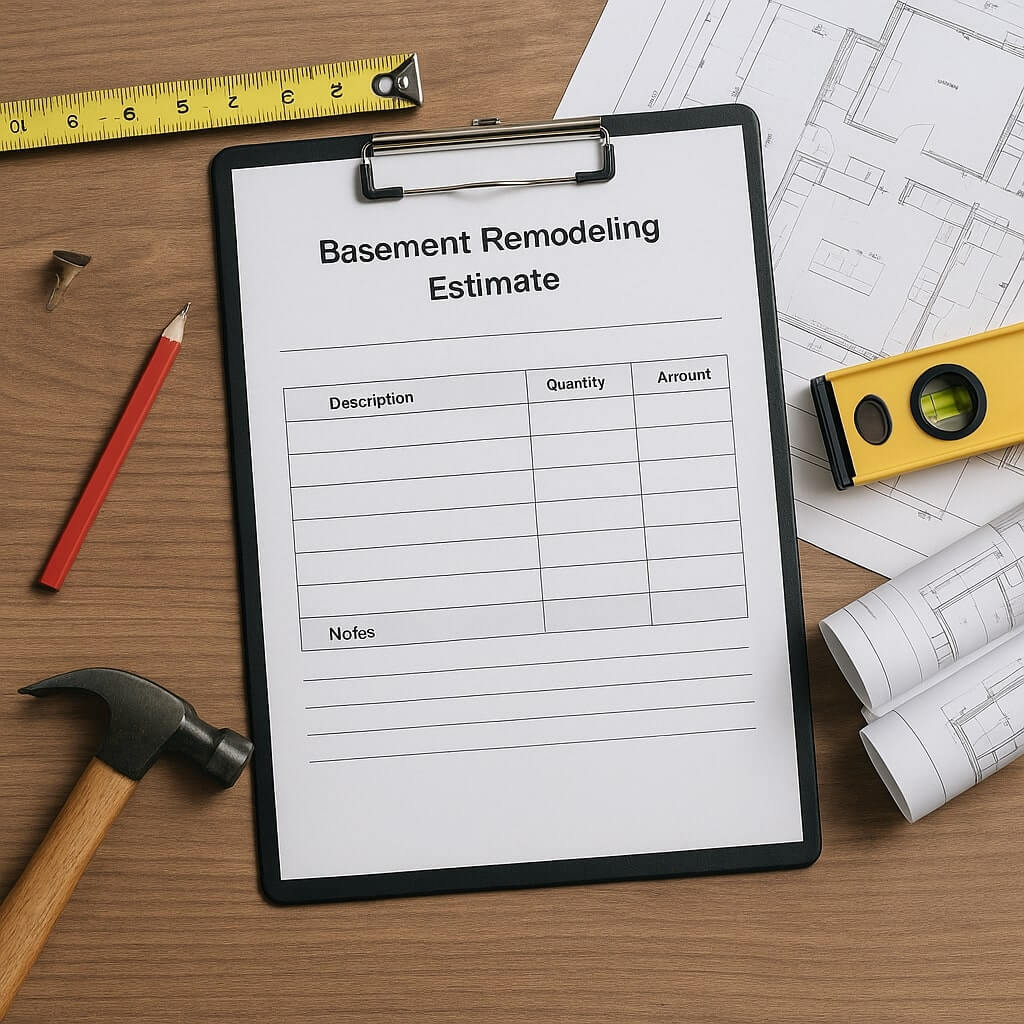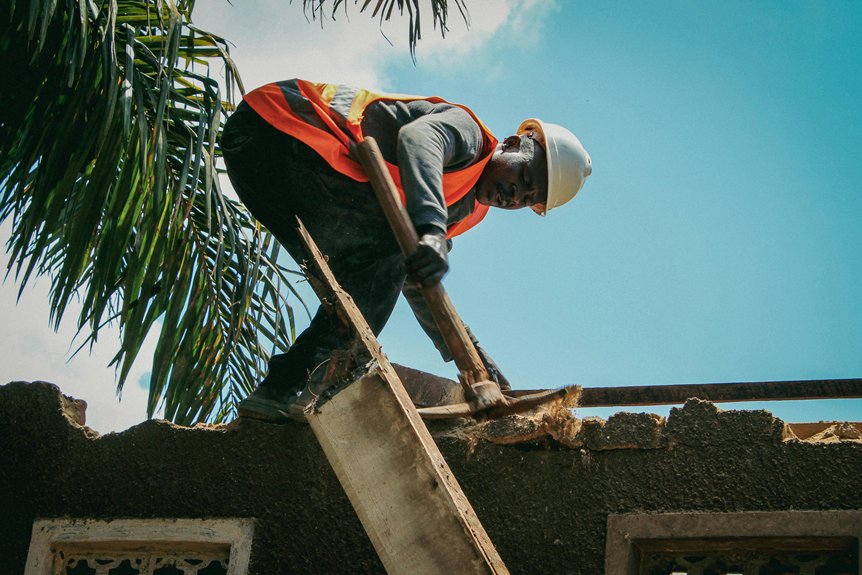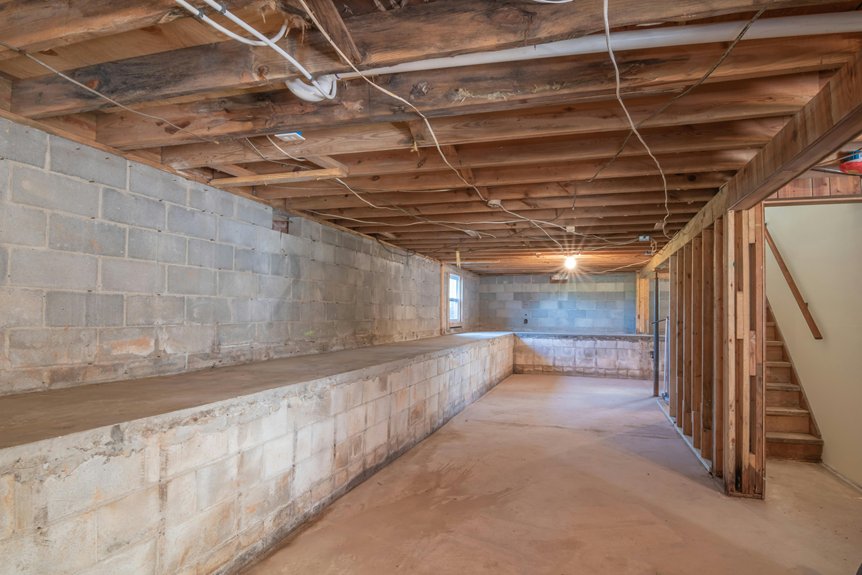When planning a basement remodel, it’s essential to create an all-encompassing estimate template that covers all bases. You’ll need to define the project scope, analyze material costs, and assess labor expenses. Additionally, understanding permitting fees and setting a contingency fund is critical. A structured timeline and clear payment terms can also guarantee smooth progress. Each element plays a significant role—let’s explore how they can transform your remodeling approach.
Key Takeaways
- Project Scope: Clearly define layout, functionality, and design goals to align client expectations and guide the remodeling process effectively.
- Material Costs: Include a cost comparison chart to evaluate and select materials based on quality, sustainability, and budget constraints.
- Labor Expenses: Break down labor costs, including wages and specialty skills, and estimate project duration with milestones for accurate budgeting.
- Permitting and Inspection Fees: Account for necessary permits and inspection fees to ensure compliance and avoid delays during the remodeling process.
- Contingency Fund: Allocate 10-20% of the budget for unexpected expenses to maintain financial control and protect the project investment.
Detailed Project Scope

When you commence a basement remodeling project, it’s crucial to define the detailed project scope to guarantee clarity and alignment among all parties involved.
Clearly outlining your project goals guarantees everyone understands what you’re aiming to achieve. This includes specifying the desired layout, functionality, and design elements.
Additionally, you must address client expectations, detailing timelines, budget constraints, and any specific features or materials requested. By doing so, you mitigate misunderstandings and foster a collaborative environment.
Addressing client expectations clearly helps prevent misunderstandings and promotes a collaborative renovation experience.
A well-defined project scope serves as a roadmap, guiding the team throughout the renovation process and ultimately leading to a successful outcome that meets your needs.
Material Costs Breakdown
When planning your basement remodel, understanding the types of materials available is essential for making informed decisions.
You’ll want to utilize a cost comparison chart to evaluate prices while considering the balance between quality and price.
This breakdown will help you allocate your budget effectively and guarantee your project meets both aesthetic and functional needs.
Types of Materials
As you commence on your basement remodeling project, understanding the various types of materials and their associated costs is essential for effective budgeting.
You’ll encounter options ranging from sustainable materials, such as bamboo and recycled insulation, which offer environmental benefits, to luxury finishes like granite countertops and custom cabinetry that elevate aesthetics.
Each material type influences not only the overall cost but also durability and maintenance.
Prioritize your choices based on your design goals and budget constraints, ensuring you achieve a balance between functionality and visual appeal.
Careful selection can greatly impact the success of your basement transformation.
Cost Comparison Chart
Selecting the right materials is only part of the equation; understanding their costs is equally important for your basement remodeling project.
A detailed cost analysis helps with budget planning and guarantees you make informed decisions.
Here’s a breakdown of common material costs:
- Drywall: $10-$15 per sheet
- Flooring (Laminate): $2-$6 per square foot
- Insulation: $0.50-$1 per square foot
- Paint: $25-$60 per gallon
Quality vs. Price
While balancing quality and price might seem challenging, it’s crucial for a successful basement remodeling project. Conducting a value assessment allows you to weigh the benefits of high-quality materials against their costs.
For instance, investing in durable flooring or moisture-resistant drywall may increase upfront expenses but often pays off through longevity and reduced maintenance. Keep budget considerations at the forefront; allocate funds wisely to prioritize key areas.
Labor Expenses
When estimating your basement remodeling project, understanding labor expenses is essential.
You’ll want to analyze the labor rate breakdown to guarantee you’re accounting for the expertise required, along with project duration estimates to gauge overall time commitments.
This thorough approach will help you create a more accurate and realistic budget.
Labor Rate Breakdown
Understanding the labor rate breakdown is essential for accurately estimating the total cost of your basement remodeling project.
Consider these four components when evaluating labor expenses:
- Hourly Wages: Base pay for skilled tradespeople, influenced by labor market trends.
- Overhead Costs: Expenses like insurance and tools that contractors factor into pricing.
- Profit Margin: A percentage added for the contractor’s profit, reflecting competitive pricing.
- Specialty Skills: Additional costs for specialized labor, such as electrical or plumbing work.
Project Duration Estimates
Estimating the project duration is essential for managing labor expenses effectively during your basement remodeling.
You’ll want to break down the project into specific milestones, such as framing, electrical work, and finishing touches. By setting realistic timelines for each phase, you can better predict labor costs and avoid budget overruns.
Be prepared to make timeline adjustments as unforeseen issues may arise; this flexibility will help maintain your budget and schedule.
Regularly monitoring progress against your project milestones guarantees you stay on track, allowing you to allocate labor resources efficiently and minimize expenses throughout the remodeling process.
Permitting and Inspection Fees

Securing the necessary permits and undergoing inspections are essential steps in any basement remodeling project.
Understanding the permitting requirements can save you time and money.
Here’s a breakdown of potential fees involved:
- Building Permit: Required before starting construction.
- Electrical Permit: Needed for any electrical work.
- Plumbing Permit: Crucial if plumbing is modified or added.
- Inspection Fees: Charged during the inspection process to guarantee compliance with local codes.
Contingency Fund
While planning your basement remodel, it’s essential to set aside a contingency fund to handle unexpected costs that may arise during the project.
Effective contingency planning involves allocating about 10-20% of your total budget for unforeseen issues, such as structural repairs or plumbing surprises.
This financial buffer guarantees you won’t compromise on quality or delay the project due to unexpected expenses.
By anticipating potential pitfalls, you can maintain control over your budget and timeline.
Remember, a well-prepared contingency fund not only protects your investment but also provides peace of mind throughout the remodeling process.
Don’t overlook this critical aspect!
Timeline for Completion
Establishing a clear timeline for completion is essential to guaranteeing your basement remodeling project stays on track and meets your expectations.
To create an effective timeline, consider these project milestones and completion factors:
- Initial Design Approval – Confirm plans and specifications.
- Permit Acquisition – Obtain necessary building permits.
- Construction Phase – Schedule demolition, framing, and electrical work.
- Final Inspection – Ensure all work meets local codes and standards.
Payment Terms and Schedule

When planning your basement remodeling project, it’s crucial to understand the payment terms and schedule to avoid any financial surprises.
Clearly outline accepted payment methods, such as credit cards, checks, or electronic transfers, to facilitate smooth transactions.
Clearly specify payment options like credit cards, checks, or electronic transfers to ensure seamless transactions throughout your project.
Establish payment milestones tied to project phases, like an initial deposit, mid-project payment, and final balance upon completion. This structure not only promotes financial clarity but also aligns with project progress, keeping both parties accountable.
Be certain to include these terms in your estimate template, giving you a solid foundation for a successful remodeling experience.
Conclusion
Incorporating these seven essential elements into your basement remodeling estimate template guarantees a thorough understanding of the project. By clearly defining the project scope, material costs, labor expenses, and other critical factors, you set the stage for a successful renovation. This structured approach not only helps manage expectations but also facilitates smooth communication throughout the process. Ultimately, a well-prepared estimate empowers you to make informed decisions and navigate any challenges that may arise during your remodeling journey.




